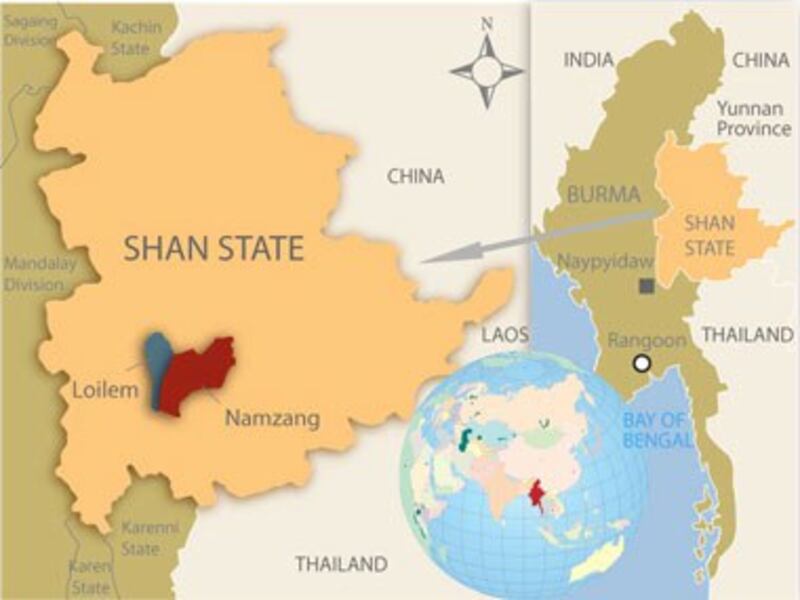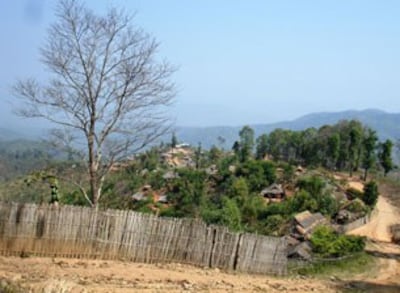ALONG THE THAI-BURMA BORDER—“I have had this for four years,” said Loong Wan, as he rolled up his pants to reveal several red, painless welts on both legs.
Similar nodules were scattered symmetrically on his arms, body, and face, including his earlobes.
“Sometimes, when I work, they are worse,” he added. “But they are always there, and more are coming up.”
Loong Wan, a farmer in his 50s, looks considerably older, a consequence of his illness and lifelong sun exposure.
Originally from Namzang Township in Shan State, he first sought treatment at nearby Loilem, without success.
“Did you have a hospital or clinic in your hometown?” I asked.
Loong Wan shook his head.
He eventually fled to the Thai-Burma border, where we met inside a bare-bones clinic of wood and concrete.
Staff medics there are able to care for most common ailments, but Loong Wan’s condition stumped them.
The potential etiologies for such long-lasting lesions are few.
Among the most likely was leprosy, a disease that the Burmese government had declared eliminated in 2003.
This achievement resulted from "the active participation of health staff and people under the leadership of the government," touted The New Light of Myanmar, the regime's mouthpiece.
In this clinic, as is the case for most of eastern Burma, infrastructure for confirming leprosy is lacking, and we referred Loong Wan to a hospital in Thailand, a short truck ride away.
Decades of abuse
Home to dozens of ethnic groups, eastern Burma, including Shan State, has witnessed decades of civil conflict.

The Burmese government response to these struggles for autonomy has been brutal:
Since 1996, more than 3,500 villages have been destroyed, abandoned, or forced to relocate, leaving almost 500,000 civilians living as internally displaced persons (IDPs), a scale comparable to Sudan’s Darfur.
Some 1,600 of these villages are in Shan State, which hosts more than 135,000 IDPs.
Abuses against civilians by the Burmese army or Tatmadaw are rife, including seizure or destruction of food, forced labor, rape, torture, and extrajudicial execution.
The brunt of this policy is directed at central Shan State, including in Loong Wan’s home of Namzang.
Last July-August, Tatmadaw troops forcibly relocated almost 40 villages, displacing 10,000 Shan villagers, in three townships just north of Namzang.
Yet for every villager directly injured or killed by the Tatmadaw, far more suffer or die indirectly from the actions of the Burmese military regime.
Despite having an estimated U.S. $5 billion in international reserves, official spending on health is 70 cents per capita per year, among the world’s lowest.
The lion’s share of the budget is diverted to the military or lavish vanity projects such as a new capital city, Naypyidaw [Abode of Kings], which cost more than U.S. $4 billion.
Forced to pay for all medical services, if any are available, health care remains an unobtainable luxury for most Burmese, 70 percent of whose household spending is on food alone.
The end result: Basic health indicators such as infant, child, and maternal mortality rates are among the highest in Asia.
One-third of Burma’s children are malnourished. And HIV/AIDS, tuberculosis, respiratory infections, and diarrhea prematurely claim the lives of thousands every year.
Devastating figures

The situation is worse for IDPs of eastern Burma.
A 2006 report titled Chronic Emergency, published by ethnic health workers serving IDPs in eastern Burma, found that almost 10 percent of children die before age 1, and that over 20 percent—that's more than one child in every five—dies before age five.
These figures far exceed those published by the junta and approach those in disaster zones such as Angola and Somalia.
And the figures are closely tied to abuse: Forced displacement, experienced by almost 10 percent of households, tripled the odds of child malnutrition and death.
In December 2009, Nobel Economics laureate Joseph Stiglitz visited Burma, advising the country’s rulers to increase spending on health and education.
Within days, news broke that the Burmese regime instead spent U.S. $570 million on 20 advanced jet fighters from Russia.
Meanwhile, militarization of the country’s eastern ethnic states and assaults against civilians continues, and international humanitarian access to IDPs remains blocked by the Burmese government, forcing most villagers such as Loong Wan to rely on community-based initiatives for support.
'Attached to our land'
“We Shans are very attached to our land. We never want to leave,” said Sai Hkam, a community leader, as we trudged down a dirt path towards Thailand, raising small clouds of dust.
We had no idea if we were in Thailand or Shan State, as nothing indicated where the actual borderline, which runs through the community, might be.
“If you go to Mongnawng [in central Shan State, and whose name means Lake Town], you won’t find a lake there. But the founders of the town moved there from the north. Their old town, Mongnawng, was by a lake,” he said.
“However, when they founded a new town, they used the same name. We never like leaving our homes … We want to go home, in Shan State, when we can. But that can only happen if democracy and peace return.”
Sai Hkam smiled wanly as we passed a group of ragged villagers, struggling to carry water and supplies up the hill, amidst the swirling dust.
“This is what happens when you have no country to call your own.”
Voravit Suwanvanichkij MPH, MD, is a research associate of the Center for Public Health and Human Rights, Johns Hopkins Bloomberg School of Public Health in Baltimore, Maryland. He has worked with local community-based organizations on issues related to health, migration, human rights, and Burma since 2001.
